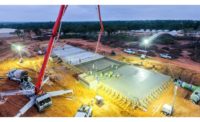Building Relationships
Staying rooted in a market also allows Clark to forge lasting relationships with key subcontractors. During the recession, having a cadre of subs it can trust is vital for survival, says J.L. Herndon, Clark senior vice president. “We've worked with a lot of these [subcontractors] for years and the ones that were solid players for us in the past are still solid today,” he adds. “A lot of them have offices around [Texas] so we know we can count on them wherever we go.”
Partnering is a critical part of Clark's approach. On megaprojects, joint venture partners are often required to help companies spread risk and stay within bonding capacity. The firm frequently teams with other big national players, such as McCarthy at the New Orleans VA project and Hunt Construction at the San Antonio medical center.
Bob Decker, executive vice president at Hunt Construction Group, notes that his firm has worked with Clark on projects for decades, in part because the two privately held firms have compatible cultures. Although the two firms often compete against each other for work, that divide is bridged during a joint venture.
“If there are any secrets between Clark and Hunt, they are few and far between because of our long-standing relationship together,” he says. “We each have our own respective business practices, but in the field we are completely integrated. We don't want a client to know who works for Clark and who works for Hunt.”
But the team also partners with regional players, such as with Thos. S. Byrne on its recent San Antonio Airport project. “Local partners have local knowledge that is invaluable,” Herndon says.
Leveraging Expertise
While local knowledge is helpful, national experience often makes the difference in winning work. Clark, which is based near Washington, D.C., has an extensive resume of federal work, so when the Dept. of Defense and others agencies began to ramp up activity a few years ago, it was well-positioned to seize opportunities. “In 2007 and 2008, everyone was focused on being in the private industry,” Jordan recalls. “We were too, but we were also trying to get into task order pools such as IDIQs [indefinite-delivery/indefinite quantity] and MATOCs [multiple award task order contracts]. The strategy was to get into these pools so that if we needed the work, it was there. There weren't many people who pursued them at the time because some contractors had the perception that it was more paperwork and more of a hassle to deal with. That was fine with us. It paid off that they had that perception.”
Clark amassed a solid resume of federal work, including complicated and innovative projects. Its assignments included early-contractor-involvement contracts, which were an emerging delivery method for federal agencies. In Fort Belvoir, Va., the firm built the New Campus East project for the National Geospatial Agency, which used an integrated-design-bid-build (IBBD) method that resembles a CM-at-risk model. “Government agencies were looking to bring practices from the private sector into the public sector,” Jordan says. “We know how to work in both of those worlds.”
When the San Antonio medical center project was bid, it was also cast as an IBDD project, which Jordan says gave Clark a leg up on the competition. “Obviously, there was a comfort in working with people they are used to, who are familiar with this delivery method and know how to apply it on the public side,” he adds
While Clark was successful in meeting its contractual goals on the fast-tracked project, its safety record far exceeded expectations. This spring, the Army Corps of Engineers honored Clark for completing 4 million man-hours without a lost time accident. Since then, the team has exceeded the 5-million man-hour mark.
Jordan credits the commitment of crews in the field for recognizing the importance of the medical center and its mission to care for wounded veterans. “If you're welding a pipe, it needs to be of the highest quality,” he says. “They are depending on this facility, so it needs to be done right.”
Building on its success, Clark now moves on to the VA replacement hospital in New Orleans. Beyond its significance for the company as a megaproject, Jordan hopes the project will create opportunities for future work. “Louisiana is a market with some barriers to entry, so the VA New Orleans project gives us a beachhead from which to look at other work that's out there and carry our reputation further into that market,” he says.




